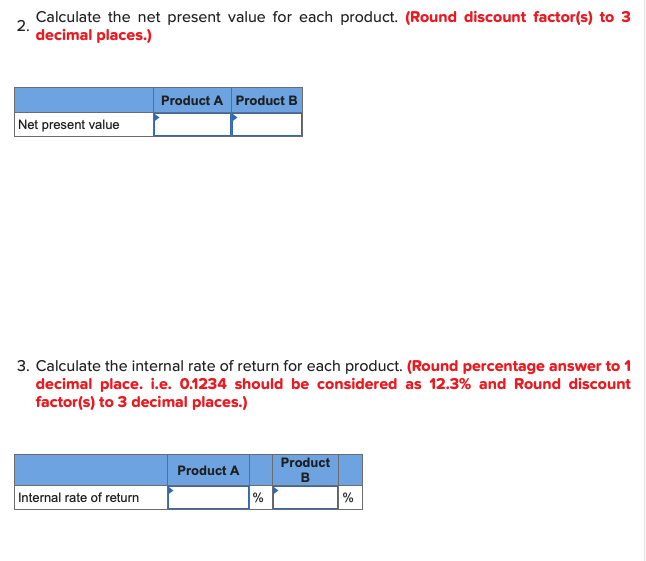


Lou Barlow, a divisional manager for Sage Company, has an opportunity to manufacture and sell one of two new products for a five-year period. His annual pay raises are determined by his division's return on investment (ROI), which has exceeded 25% each of the last three years. He has computed the cost and revenue estimates for each product as follows: Product A Product B $370,000 $ 530,000 Initial investment: Cost of equipment (zero salvage value) Annual revenues and costs: Sales revenues $400,000 510,000 $ $250,000 Variable expenses Depreciation expense Fixed out-of-pocket operating costs $ 180,000 $ 49,000 $ 91,000 $72,000 $ 85,000 The company's discount rate is 19%. Click here to view Exhibit 13B-1 and Exhibit 13B-2, to determine the appropriate discount factor using tables. Required: 1. Calculate the payback period for each product. (Round your answers to 2 decimal places.) Product A 2.74 years Product B 2.82 years Payback period 2. Calculate the net present value for each product. (Round discount factor(s) to 3 decimal places.) Product A Product B Net present value 3. Calculate the internal rate of return for each product. (Round percentage answer to 1 decimal place. i.e. 0.1234 should be considered as 12.3% and Round discount factor(s) to 3 decimal places.) Product A Product B % Internal rate of return % 5. Calculate the simple rate of return for each product. (Round percentage answer to 1 decimal place. i.e. 0.1234 should be considered as 12.3%.) Product B Product A % Simple rate of return 6a. For each measure, identify whether Product A or Product B is preferred. Net Present Profitability Value Index Product B Product A Payback Period Product A Internal Rate of Return Product A Lou Barlow, a divisional manager for Sage Company, has an opportunity to manufacture and sell one of two new products for a five-year period. His annual pay raises are determined by his division's return on investment (ROI), which has exceeded 25% each of the last three years. He has computed the cost and revenue estimates for each product as follows: Product A Product B $370,000 $ 530,000 Initial investment: Cost of equipment (zero salvage value) Annual revenues and costs: Sales revenues $400,000 510,000 $ $250,000 Variable expenses Depreciation expense Fixed out-of-pocket operating costs $ 180,000 $ 49,000 $ 91,000 $72,000 $ 85,000 The company's discount rate is 19%. Click here to view Exhibit 13B-1 and Exhibit 13B-2, to determine the appropriate discount factor using tables. Required: 1. Calculate the payback period for each product. (Round your answers to 2 decimal places.) Product A 2.74 years Product B 2.82 years Payback period 2. Calculate the net present value for each product. (Round discount factor(s) to 3 decimal places.) Product A Product B Net present value 3. Calculate the internal rate of return for each product. (Round percentage answer to 1 decimal place. i.e. 0.1234 should be considered as 12.3% and Round discount factor(s) to 3 decimal places.) Product A Product B % Internal rate of return % 5. Calculate the simple rate of return for each product. (Round percentage answer to 1 decimal place. i.e. 0.1234 should be considered as 12.3%.) Product B Product A % Simple rate of return 6a. For each measure, identify whether Product A or Product B is preferred. Net Present Profitability Value Index Product B Product A Payback Period Product A Internal Rate of Return Product A









